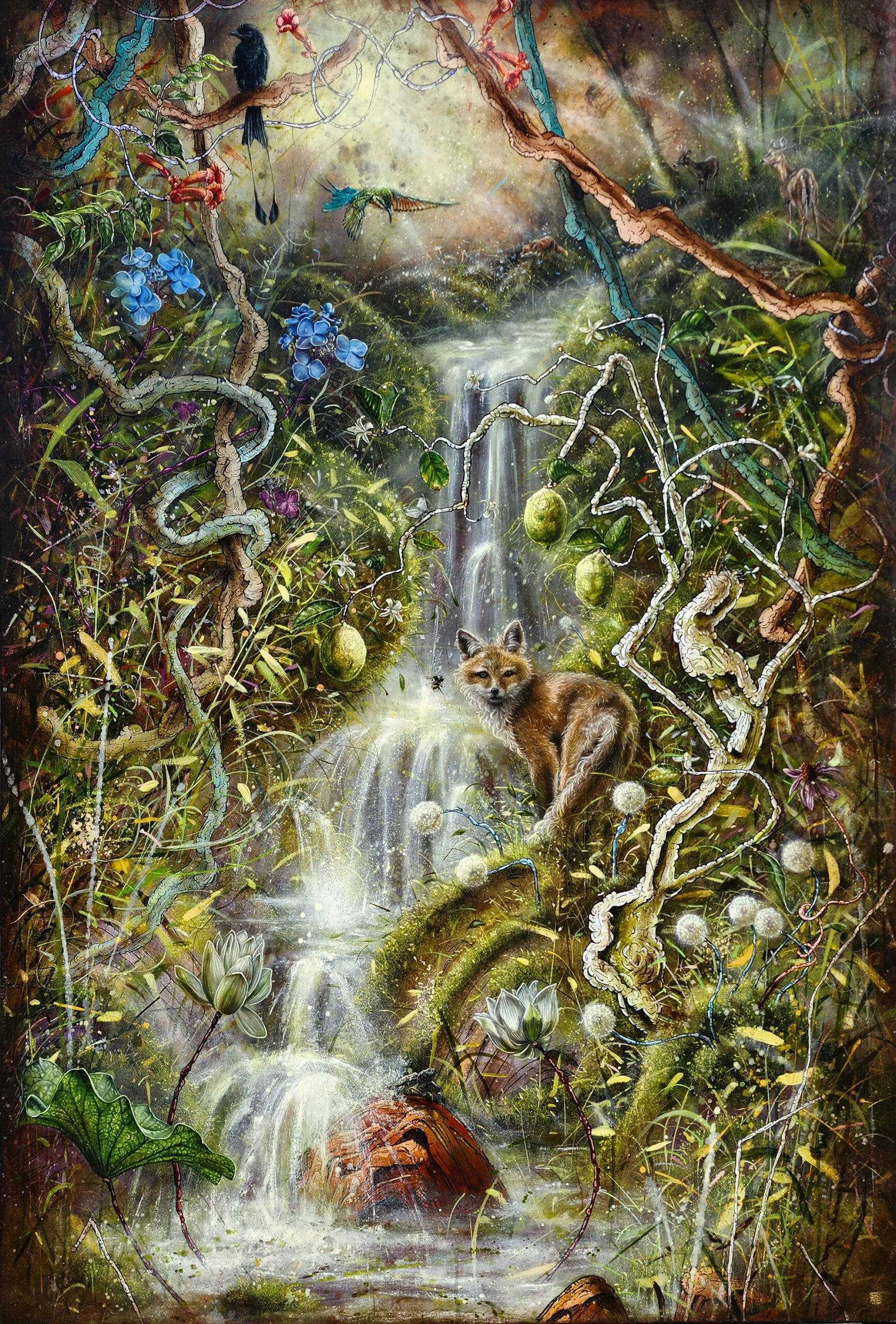By Gia Miller
Photography by Justin Negard
Deep in the forest, the morning sun is bursting through the canopy. Its rays beam down, straight into a gushing, cascading waterfall. A lone hummingbird is ready to dive in, perhaps searching for its next meal. A crow sits idly on a branch. About halfway down and slightly to the right, there’s a fox. He’s inviting you in.
No. Wait. That’s not right. Let me try again.
Deep in the forest, the late afternoon sun is bursting through the canopy. As the last rays of the day force their way into the depths of this mythical land, they illuminate nature’s charm. A gushing, cascading waterfall is surrounded by thriving wildlife. Bright red angel’s trumpets frame a lone black bird who sits above periwinkle chrysanthemums. Tremendous limes dangle from the vines. Large, lush dandelions appear to be dancing in the breeze. The hummingbird dives in, eager to drink delicious nectar. And then there’s the fox. He has a story to tell.
No. That’s not right, either. There’s more here. I’ll get it right this time.
It’s sunset in a secret garden. As the last rays of the day force their way into the depths of this mythical land, they illuminate the beauty of an untouched world. That gushing, cascading waterfall is still there, doing its thing, and wildlife is thriving all around it. But so are the vines. And they appear to be strangling some of the beauty. Did we do that? Is all this nature thriving, despite us? Perhaps the dancing dandelions are reminding us that perfection—the perfect lawn, the perfectly sculpted tree—may not be as beautiful as we’d hoped. Instead of that loud beauty, the land now appears to be more tranquil. There’s harmony here, and nature is doing what it can. And…oh look, next to the fox is a tiny, buzzing bumble bee. He’s warning the fox of our presence. The fox isn’t welcoming us; he’s unnerved by our existence. This is his secret garden, and we must tread carefully.
“I’m fine with a quick read,” says South Salem-based fine artist Nathaniel Aric Galka. “When my work is in a show, I’ll step back and watch. When people first come in, they’ll look quickly, but as they go through the paintings, they get slower and slower. They become more involved in the paintings, and that’s what I love. I want people to enjoy them immediately, but then pause; pause just to be amazed by it.”
“Welcome to the fabled forest…”
Born just outside of Chicago, Galka grew up in Boca Raton, FL. His mother was a fine artist who, for the last decade of her life, produced artwork with only 15 to 20 percent of her vision remaining (legally blind), and his father, a businessman, eventually joined his father-in-law’s business, Maya Romanoff, which produces handcrafted wallcoverings featuring items like glass beads, gold leaf, seashells, wood and stitching.
“I was always around very eccentric, artistic people—true creatives,” Galka describes. “They were people with money, but they really embraced creativity. I was also around incredible, beautiful antiques.”
He was especially close to his grandmother, who, he says, “had an affinity” for him.
“She saw I was a very delicate child, so she was very gentle with me,” he remembers.
When her husband retired, his grandmother “basically just got up and left without telling anybody; she went to the Orient.”
“She spent like nine months in China, Taiwan, Japan and South Korea—she loved South Korea,” Galka remembers. “I would get a crate about once a month filled with Asian antiquities and kimonos. I was seven or eight years old, and I would run down the streets in a kimono that was four sizes too big.”
Galka was an art prodigy. He drew an “anatomically correct” whale when he was three years old, and a year or so later, he drew a horse that no one thought a four-year-old could have drawn.
“I took children’s art classes until I was about six years old,” he remembers. “Then I went into adult painting classes. I was no longer with anybody under the age of 30.”
Galka sold his first watercolor painting at eight years old, and by age nine, he was painting murals in people’s homes. Galka was 14 when his work was first featured in a gallery.

Nathaniel Galka
“A curious thing…”
At 12 years old, Galka experienced a culture shock: his family moved to Knoxville, TN. After the move, his mother petitioned the state to allow him admission to the Tennessee Watercolor Society, which had a minimum age of 18.
“I had to paint in front of the president, and when I was done, he looked at me and said, ‘You’re in.’”
During high school, Galka’s artistic talent continued to evolve, as did the disbelief.
“I had three paintings thrown out of a Scholastic art competition because they thought they were too good for a student my age,” he remembers. “They kicked me out for fraud, thinking my mother did it. One of them was a portrait done on gold leaf. My art teacher had to tell them I actually made those paintings in class, and I had to show enough work to be allowed back into the competition.”
Galka continued to take adult painting classes outside of school; it was where he felt most at home.
“The other students were mostly 65-year-old women, and I loved it,” he says. “I learned manners, etiquette and respect from them, probably more so than most people my age. And, because I was such a precocious thinker, it was a place where I could engage in conversations as an adult.”
During the summers, he participated in elite art programs like the Tennessee Governor’s School for the Arts and the Marie Walsh Sharpe Art Foundation in Colorado Springs. When it came time for college, Galka says he was the “highest-earning scholarship winner” for each school he was accepted to.
“This is where I made the biggest mistake of my life,” he says, almost as a point of fact rather than a regret. “I was given the Andy Warhol Foundation Grant at Carnegie Mellon—they only give out one a year. Instead, I went to Columbus College of Art & Design (CCAD) because they had a profound technical and historical approach to traditional painting and technique. The other schools were more cerebral or conceptual, and it just didn’t fit my demeanor. I realize my career could have been completely different, but I’m fine with where it is.”
College was the first time Galka felt he was on a level playing field, talent-wise, with his classmates; he finally felt challenged. After CCAD, he pursued a graduate degree in photography at Northwestern University.
“I thought I had to compete with the rest of the fine art world, which was focusing on photography at the time,” he explains. “I completely abandoned painting to be hip and cool with the rest of the art world. I was fully manipulated by the trend, which is insane. In retrospect, trends are the kiss of death for a fine artist. Trends are for fashion or interiors, not for fine art. Fine art is about the emotion of the artist, and that is it.”
Galka describes the program at Northwestern as “the most horrendous waste of two years; it was horrible.” He says the art department was “in chaos” during his time there. He initially refused to write the requisite 200-page thesis (“Why should I have to do something that will have no bearing on my career?”), but he eventually handed in “a mess,” and finally, they told him to “get out.”
About a year and a half later, Galka received his diploma in the mail. He laughed hysterically.
Soon after, Galka fell into a “full drug- and alcohol-induced rager” that lasted several years.

“Frogie’s swimming hole…”
“I got the gossip…”
“I had to be their prodigy,” Galka says, referring to his parents. “I had to be their symbol of success. Nobody gave me the skills, nobody gave me the direction, and nobody showed me how to be independent. Everything I had done so far was solely based on their expectations and what I was supposed to do. I fell victim to a cliché, and I had a complete mental breakdown.”
Aside from showing off their prodigal son, Galka says his parents didn’t really parent him.
“I’m now coming to the realization that I never had parents,” he says. “I had guardians that made sure I stayed alive, but I never had parents. I never had anybody teach me how to socialize or regulate myself. By the time I was six years old, I was making my own dinners and riding my 10-speed bike, which was way too big for me, on Dixie Highway. That should not have happened.”
“They were so micro-visioned,” he continues. “All they saw was this innate talent at a really absurd level.”
But Galka doesn’t fault his parents; he believes they did the best they could. He says they had “very, very traumatic upbringings,” and, he’s come to realize, they thought it was better not to parent their son than to repeat the parenting mistakes of their childhood.
“There is more to the story…”
As young Galka raised himself, he created his own little world, inspired by the treasures from his grandmother’s travels, the beautiful furniture and antiques throughout his home, the creative people who weaved in and out of his life and his favorite movies.
“I often tell people that when I was a child, my babysitter was basically reel-to-reels of movies like ‘Snow White,’ ‘Cinderella,’ and ‘Sleeping Beauty,’” he describes. “I grew up watching them over and over again. And because I lived near Disney World, I became engrossed with the old way they made cartoons—layer upon layer.”
Those fantasy worlds were evident in Galka’s work from the time he was six years old. And he draws upon that same inspiration today.
Just like in “Snow White” and “Cinderella,” you’ll find magical forest creatures and critters in his paintings—some appear engrossed in conversations with their friends, and others seem curious, if not a little timid, about you, the human, entering their world. And those knotted, twisted vines that wrap themselves around Galka’s magical forests unquestionably resemble the forest of thorns in “Sleeping Beauty.”
He even employs a “scrim” (or layering) style similar to that of early Disney artists.
“How I paint is by literally adding one more ‘gel of a cartoon’ on top of the other until I have this full forest that’s invented layer by layer,” Galka describes. “And when you get down to it, I probably have anywhere between 40 and 300 layers of scrim, like you would in a cartoon.”

"Welcome to the Fabled Forest..."
“Where I need to be… is here…”
Ten years after his breakdown began, Galka met his first husband, Patrick.
“He came over to my place on the first date and saw one of my drawings when he walked in,” Galka remembers. “He said, ‘Oh, that’s really pretty; who did that?’ And I said, ‘I did these.’ He asked me if my work was in galleries, and I said, ‘No, I don’t do that anymore.’ He responded, ‘Well, that’s a f*@! waste.’ And it hit me—that’s what I was supposed to do. So, I started dabbling.”
When Patrick died of suicide in 2011, Galka’s work was featured in galleries in Brooklyn, Atlanta, Asheville, NH, and Columbus, OH. But it was Galka’s current husband, Carl J. Lana, whom he met almost exactly one year later, who lovingly showed Galka what he was capable of.
An interior designer, Lana’s education and background in decorative arts provided Galka an entirely new perspective on art. When they went to museums together, Galka says he “saw artwork completely differently.”
“I would not be painting any of this if it wasn’t for Carl,” says Galka. “I did not understand my own abilities until I met him. And I never would have understood what I was actually doing; I was making beautiful works, but I never understood the magnitude of what I could make. He taught me the essence of delicate behavior and the subtleties of elegance by taking me to museums like The Metropolitan and The Frick.”
“And that’s the beauty of having him in my life,” he continues. “I wouldn’t be creating these works if it wasn’t for his understanding of taste. He’s refined my taste to a point where I now know who I’m supposed to be. And that’s the most beautiful thing he’s ever given me, among other things. But that is truly the biggest gift I was ever given. He’s the perfect partner in life for me, and, I hope, vice versa.”
Lana also placed Galka’s work in front of his design clients, which helped Galka build his reputation. Today, they co-own Sandra Rose Home, a consulting business and shop that’s named after their mothers, “who were creatives in their own right, but their talents and abilities were overlooked.”

Nathaniel Galka & Carl Lana
“Flutter silently with beauty…”
In addition to the cartoons of his childhood, Galka’s paintings are also inspired by the nature around him. He takes two-hour walks every day to stay grounded, and he photographs what he sees. For Galka, it’s not the overall landscape that intrigues him; it’s the nuance. It’s the conversation between the bee and the squirrel, or the dragonfly and the flower that captures his attention.
“He puts human interactions, personalities and emotions into his creatures,” Lana points out. “He allows them to have conversations with each other.”
And Galka also stops to notice the colors; he has a “fine-tuned sense of color.”
“For example, here in this leaf,” he says, pointing to a vase of tulips on the table, “I see Robin’s egg blue, lemon yellow, green viridian, Kobe green, Italian ochre—I can see all those things in one leaf. Right now, I’m painting white rose petals, and while most people might use three or four brushes, when I’m done, I have probably gone through 32 brushes. All the nuances of the color are in those brushes.”
Galka’s connection to nature also influences his life choices, including what he eats (he’s been a vegan since he was eight) and the products he uses in his work. His canvases are either linen or jute, which are plant-based sustainable fabrics.
He begins each new piece by creating a gesso—an Italian “paste” first used around the 14th century to prime panels before painting—out of Carrera marble that he grinds and colors. He “trowels it on with a blade,” creating three to five layers to fill in the fabric’s crevices. Then he adds a layer of shellac to seal in the plaster; it’s the only animal-based product Galka uses, which, he emphasizes, does not kill the shellac bug.
“I have zero clue what the painting will look like when I begin,” he explains. “I start with abstract blurred backgrounds, and then I put in a tree or something. From there, it just grows. I don’t know any other way to say this kind of statement, but my paintings develop like nature.”
His next move is to spray some archival Krylon spray paint into a cup, dip his paintbrush and begin “making marks,” which dry immediately.
“The immediacy reflects our current culture, our media, the fast fashion, things like that,” he explains. “It’s about how we can’t waste time.”
Next is “pen and ink,” a sketching method Galka employs throughout the entire process, using a very specific pen and ink well from 1910.
“The ink is also a shellac-based, India ink,” he notes. “It is one of the most permanent things you can do, and it’s also the only thing that does not separate from the oil and then bubble up. So, I’ll make a layer of that, then I’ll do some realism, then some slash painting, and then I’ll go back in and put something else. And that’s how the layering develops.”
To create the hair on the golden snub-nosed monkey in “Frogie’s swimming hole…” (back cover), for example, Galka will paint approximately 15 layers, and he uses between 40 and 75 paintbrushes each day, some for various shades of a color and others for their thickness.
Galka paints with plant-based oil paints, and he makes his own black. To clean his brushes, he uses Oil of Spike Lavender or gum spirit turpentine, which, he explains, is made from pine, not petrol or fossil fuels. But even if the brushes are clean, oil-based paints dry slowly, so as he waits for the paint to dry before adding another layer, he works on another painting.
“This bird,” he says, referencing the same painting, “took about a week and a half to paint, which factors in the drying time, the reworking, the redevelopment and realizing that one wing is too dark and needs to be lightened. I paint about 70 percent of something, and then I alter it slightly so it works with the composition. So, hypothetically, the front of the head might have been wider, but I’ve got to change it so the light is coming from behind.”
As Galka creates his layers, he’ll add chalk lines when there’s a thought or idea he wants to consider and painter’s tape when the idea is more permanent. It takes him around nine months to make three to five large paintings.

Galka's pen and ink well from 1910.
“A gardens revolution…”
Ask Galka for the meaning behind his work, and he’ll say it’s up to the viewer, but he provides some guidance through the titles. Give him a few more minutes, and he will begin to speak fervently about his passion for the earth, along with his frustration with the human race. For example, the dandelions throughout his paintings reference our “overconsumption” (meaning our excessive consumption of products to such an extent that it causes harm to our environment and ecosystems).“When you allow dandelions and things like that to exist, you’re allowing nature to resume its place,” he explains. “You’re no longer consumed with the vanity of a perfect yard and overconsumption. That’s why the dandelion poof is so important in my paintings.”
Or the specks of gold leaf in his paintings are an homage to the Japanese practice of kintsugi, which mends broken ceramics with gold. It’s a reference to how, as a society, we’re broken. But it’s deeper than that.
“This painting has two messages,” he explains, referring to “Frogie’s swimming hole…” “It’s about the awe of nature, the wonderment, the childlike curiosity of seeing something for the first time. It’s about intimacy and solace. It’s about private moments. And it also speaks to the human hand that’s in the painting—not my human hand, but how humans exist. It’s about the alterations we’ve made to our environment and what we have done to our ecosystem. This painting is post-human. Everything is already covered up, all the garbage; everything we’ve done is 20,000 feet under this.”
In “Welcome to the fabled forest…”, Galka’s fawn (symbolizing youth) is tugging on the vine, hoping to gain knowledge from the apple, and the other creatures are cheering him (or her) on. The message here, Galka says, is about our “diminishing knowledge and awareness of how we are protecting our precious nature.”
This story’s cover image, “Wandering through a constellation of a golden sunset…”, illustrates “the symbiotic relationship between creatures.” And it’s a challenge to the viewer: Is the fox inviting you in, or is the bee warning the fox that he is not alone?
“The painting is also about how we are protected and supported by creatures like the bee; without it, we would not exist.”
In much of his recent work, the bee has been a prominent figure. In fact, the titles of Galka’s works are based on the bee’s point of view. But he’s expanding. He recently learned just how important other pollinators are, so he’s making a conscious effort to include those in his work, too.
“Wasps, hornets and the like are going to the same foods for nourishment as the bee, and they are pollinators, too,” Galka explains. “In fact, the largest pollinators on earth are moths. [Note: In 2023, researchers at the University of Sussex found that moths are more efficient pollinators than bees.] So, if you are killing them, you’re killing what is going to feed us. Please don’t forget about the other pollinators.
As Galka learns, he tries to teach others. And, he points out that even though many of the animals in his paintings don’t actually coexist (for instance, English butterflies with Chinese monkeys), his message is about the pollinators and saving our environment.
Overall, Galka’s paintings feature a delicate complexity you can only truly experience in person. The layers of flora and fauna, the depth of the forests, the detailed hairs on each animal, the seemingly endless creatures often hidden in plain sight (Did you discover the frog in “Frogie’s swimming hole…” yet?)—they’re all inviting you in, asking you to pull up a chair and stay for a while, challenging you to think hard about how you’re helping or harming the planet.
“I just want to live in the beauty of a construct that’s as peaceful and loving as possible, and that’s also what a lot of these paintings are about,” he says. “They’re about the harmoniousness and conjunction of nature. We really need to step back; nature has its purpose.”
Galka’s work will be on display from May 4 to June 9 at Carol Corey Fine Art in Kent, CT, in a show titled “A world between worlds…”
This article was published in the May/June 2024 edition of Connect to Northern Westchester.












